| 다른 이름들 | 종이 절단 칼, 종이 단두대 블레이드, 단두대 칼, 단두대 기계 칼 |
|---|---|
| 원산지 | 중국 |
| 애플리케이션 | 플라스틱, 종이, 보드, 필름, 호일, 라벨, 포장, 골판지, 잡지, 책 |
| 재료 | 65Mn,9CrSi,Cr12MoV,SKD-11,HSSl |
| 모델 번호 | GP-GB |
| OEM 서비스 | 사용 가능 |
| 지불 조건 | L/C, T/T, 웨스턴 유니온 |
| 패키지 | 판지 상자, 나무로 되는 케이스에서 |
| 배달 시간 | 7~20일 |
공유 대상:
Guillotine blades, also known as guillotine knives or straight cutting blades, are long, straight cutting tools used in guillotine cutters or shearing machines. These machines are designed to make straight, precise cuts across a wide range of materials, most commonly paper, cardstock, and thin boards in the printing and paper converting industries, but also metals, plastics, and other materials in industrial shearing applications. The term “guillotine blades” refers to the straight blade or set of blades that descend in a shearing motion to cut the material held firmly in place.
Guillotine blades are essential tools in various industries for making clean, straight cuts. Key applications include:
The materials used for guillotine blades must be durable, wear-resistant, and capable of maintaining a sharp, straight cutting edge to ensure clean and accurate cuts over extended use. Common materials include:
The blades are precision ground and often hardened and tempered to achieve the optimal balance of sharpness and durability. The bevel angle of the cutting edge is critical for the specific material being cut, ensuring a clean shear without tearing or crushing.
Guillotine blades are typically long and straight, but variations exist in their edge profiles and overall design depending on the application and the material being cut:
The working principle of guillotine blades involves a powerful downward shearing motion against a stationary bed or anvil. The material to be cut is held firmly in place by a clamp, and the sharp, straight blade descends with significant force, cleanly severing the material. The length and thickness of the blade, the angle of the bevel, the force applied, and the rigidity of the machine all contribute to the quality and accuracy of the cut. Proper sharpening and alignment of the guillotine blades are essential for optimal performance and safety.
환영합니다 묻다!
If you don’t find the shear blade you are looking for, we can also customize it, see our “맞춤형 블레이드” to learn how!
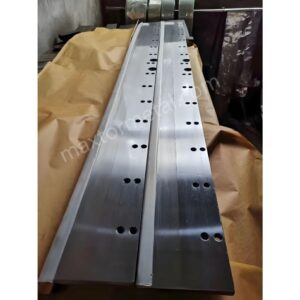



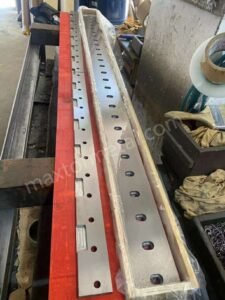
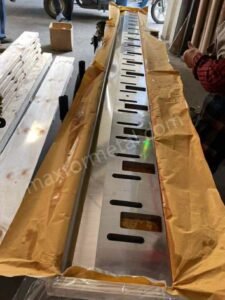
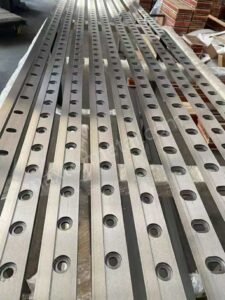
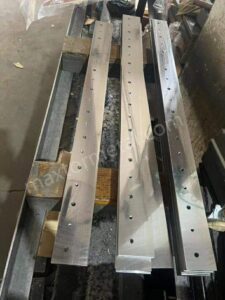
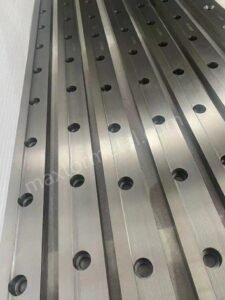
수입의 편리함을 누리기 쉽고, 운송에서 통관까지 전체 과정을 우리가 처리해 드립니다. 귀하는 VAT만 지불하고 상품이 회사에 도착할 때까지 기다리시면 됩니다.
우리는 수많은 응용 분야에서 블레이드가 사용되는 것을 보아 왔으며 정확성, 내구성 및 타의 추종을 불허하는 경쟁력 있는 가격을 제공하여 귀하가 진행하는 모든 프로젝트를 처리할 준비가 되어 있습니다.
도면, 스케치 또는 샘플을 제공하든, 우리는 귀하를 위해 도면을 그리고 제조할 수 있습니다. 또한 거의 모든 산업용 툴링 애플리케이션을 개선하기 위해 기존 설계 및 사양을 수정하는 데 도움을 줄 수 있습니다. 귀하의 특정 요구 사항에 대해 논의하려면 전담 영업 팀에 문의하십시오.
품질을 관리하기 위해 첫 번째 제품 검사, 입고 자재 검사, 인증된 자재, 진행 중 품질 검사, 최종 품질 검사를 포함한 일련의 테스트와 검사를 수행합니다.
귀하가 수입업체, 유통업체, 도매업체 또는 최종 사용자이든, 우리는 최소 MOQ, 번거로운 문의 없음, 더 큰 구매의 자유를 통해 귀하의 참여를 환영합니다.
당신의 전담 모니터가 되어, 생산 라인의 모든 중요 노드를 정기적으로 전송하세요. 아무리 멀리 떨어져 있어도 제품의 진행 상황을 최대한 파악하세요!
난징 Metal 산업 CO., 제한
Mingjue 산업 단지, Lishui, 난징, 장쑤성, 중국